Korean cars
The Rise Of The South Korean Motor Industry
 When I was a child, I hardly ever saw a car made in South Korea. Japanese cars, yes. They were everywhere. But cars from South Korea, no. However, after about 2000, I started seeing them everywhere. What was behind the big upsurge? Was it simply the case that I didn’t notice them on the roads, or was it that they weren’t around?
When I was a child, I hardly ever saw a car made in South Korea. Japanese cars, yes. They were everywhere. But cars from South Korea, no. However, after about 2000, I started seeing them everywhere. What was behind the big upsurge? Was it simply the case that I didn’t notice them on the roads, or was it that they weren’t around?
It’s certainly the case that today, South Korean cars are among the most popular best sellers on the roads. And it’s certainly true that the South Korean motor industry has absolutely mushroomed of the past 50-60 years. In fact, this is true of many industries in South Korea. Back in the 1950s, Korea had barely any heavy industry going. Today, it’s a work leader in a number of fields, including the automotive industry.
Before we go any further, quick note: to ensure that this article doesn’t fall into the TL/DR category, we’ll refer to “Korea” from here on out instead of South Korea. North and South Korea went their separate ways in 1953 at the end of the Korean Civil War, which was when the Korean motor industry got started. Given North Korea’s political stance, we don’t hear much about their cars…
Not that politics have nothing to do with the Korean motor industry. According to one historian on the topic, the Korean government played a long-term game, creating policies and strategies that guided not just the motor industry but other industry sectors (e.g., ship building) across the years.
From Zero To Hero In A Few Decades
The Korean motor industry got started in 1953 when the US military forces on bases in the South needed more spare parts for their Jeeps. They sent up a local assembly plant with the Jeep name to make these spare parts. The owners of the company also had the bright idea of using old oil drums left behind by the army to make the chassis for their own vehicles, known as the Sibal, which were very popular as taxis. And that’s where the Korean motor industry got started.
After the success of the factory for spare parts for Jeeps, other companies started looking at Korea as a location for production lines and factories – and Jeep kept on going. These were often owned by US and Japanese car companies. This went on until 1962, when the Korean government made a law meaning that foreign companies were only allowed to set up joint ventures that local automotive companies had a share in.
During this period, a surprising number of vehicles that we think of as Japanese or American were actually put together in Korea. Mazda, Nissan, Fiat and Ford were just some of them. In fact, Kia started off as an assembly plant for Mazdas, whereas Hyundai was originally a factory for producing Ford Cortinas.
However, the joint venture model wasn’t enough for the Korean government, as they wanted to stimulate the local economy and industry, and reduce the dependence on foreign companies. In 1973, they therefore switched to focus cars that were not just manufactured in Korea but developed there as well. Some of the companies began the process of developing their own products. To do this, they often copied what they had seen during the process of putting other vehicles together, with a few wee tweaks to make them unique. This often involved using licensed parts from companies outside Korea to ensure a good quality product before the final shift to coming up with their own innovations. And things took off from there!
Hyundai – A Case Study
Hyundai is a typical example of a Korean car company that went through all the stages of imitation and innovation. This company started in the late 1960s as an assembly line for the Ford Cortina. When the Korean government called for locally designed cars in the 1970s, they got licences from other companies for various technologies and developed a locally designed car, the Pony. This was followed by the Excel in 1980. Both of these used tech licensed by Mitsubishi. Because the Excel and Pony sold so well and competed with Mitsubishi, the Japanese company didn’t renew the license for any new tech. Wanting to develop further, Hyundai grabbed technological licenses from a number of different companies just in case, and also set up a training consultancy, where trainee developers headed over to Italy to learn the principles of top car design. After 18 months in Italy, these trainees came back to Korea primed with their new knowledge.
What they (and trainees from other Korean companies such as Kia and Daewoo) had learned worked well. In 1993, the Elantra was Australia’s best-selling vehicle. After Kia and Hyundai joined forces, sales of Korean cars grew even more, until, in 2010, the Sonata and Elantra got onto the list of 10 ton best sellers worldwide. In 2013, Hyundai earned more from car sales than BMW, Honda and Peugeot. In short, the Korean motor industry is a force to be reckoned with, and Korea is certainly one of the countries you should think of when you think of places where cars are made.
You may very easily have driven or owned a Korean car at some point; although I haven’t done so personally, various friends and family members have, and they found them to be sound, reliable and good to drive.
Where To (Or From) Next?
Korean cars may be here to stay, but one has to wonder who’s next? Where will our cars come from in the future? We’ve already seen a few of the Chinese players (LDV, Great Wall and its subsidiary, Haval) enter the Australian market – will we see some of the others? Geely already owns Volvo, so will we see more actual Geely vehicles? India’s another possibility, with a few Tatas and Mahindras already hitting Australian roads. Other Asian countries currently have factories assembling vehicles for other countries, so will Thailand, Vietnam and Malaysia take the same route as Korea has done? What about countries from beyond Asia – are we going to drive vehicles from Brazil’s Effa or Uganda’s Kiira? Given the trend towards EVs and the fact that much of the world’s lithium for car batteries comes from African nations, I won’t be the least bit surprised if African vehicles started appearing on the market around the world in the next decade or so.
New Cars to Buy – Exciting!
Along with the new SUVs showcased last time, Australia will also see some other exciting vehicles arriving in the coming months. Keep your eyes out for the following:
Honda
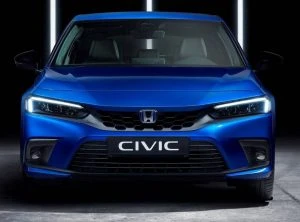
Civic Hybrid
Honda’s new Civic hybrid has its own subtle design features that set it apart from other Civic models. Hybrid-specific displays for the infotainment screen and instrument cluster gives the car its own environmentally friendly twist, plus the revised rear bumper is designed to conceal the exhaust outlets. Honda’s Civic Hybrid also gets blue accents for its Honda badges, and there is a special e:HEV tailgate badging to set it off nicely.
As a driver, the new Honda Civic Hybrid is an impressively competent vehicle with great economy and plenty of get up and go. The Civic HEV’s hybrid system is based around the 2.0-litre naturally-aspirated Atkinson-cycle petrol motor that is found in the current Honda Accord VTi-LX Hybrid. Matching the engine output to a smooth CVT automatic makes for an excellent easy car to drive. 315 Nm of torque provides grunt when you need it and the 135 kW of peak power suits this car well and delivers a bigger punch than the standard Civic’s 131 kW/240 Nm levels.
The front-wheel drive Honda Civic Hybrid is likely to be more efficient than the Accord Hybrid and even more so than Toyota’s Corolla Hybrid (4.2 litres/100 km).
BYD
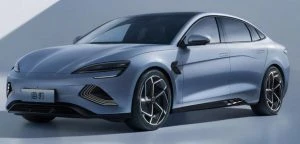
BYD Atto 4
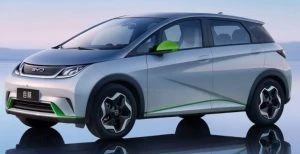
BYD EA 1 (Dolphin)
BYD Auto is the largest EV manufacturer in the world and is the automotive division of the Chinese multinational manufacturer BYD Company. Along with some SUV models, BYD is also bringing their Atto 4 sedan and their neat little EA 1 to Australia.
The BYD Atto 4 is a mid-size sedan that looks beautiful, sporty, and aerodynamic. Equipped with loads of the latest technology and also obtaining power from large batteries with a unique design, the Atto 4 impresses. Standard Atto 4 versions get a 61.4 kWh battery pack and a claimed 550 km range. The pricier models get a larger 82.5 kWh unique Blade battery with a claimed range of up to 700 km. Having the larger battery and an AWD system, this flagship BYD Atto 4 can reach 100km/h from a standstill in just 3.8 seconds!
More BYD excitement has the imminent arrival of the BYD EA 1 Hatchback. In China they call the BYD EA 1 the rather endearing name ‘BYD Dolphin’. This is a small Chinese EV hatchback that is being picked to be priced at or less than $30,000 in Australia. The small all-electric hatchback will be available with various battery and drivetrain configurations, all using a single electric motor to power the front wheels.
Two battery capacities: 30.7 kWh or 44.9 kWh will be available for the EA 1, both of which can be paired with a 70 kW/180 Nm motor. The larger 44.9 kWh battery can also be linked to a 130 kW/290 Nm motor, providing swifter acceleration and cruising speeds. Larger batteries will also become available over time for the little EA1 – particularly necessary, as Australia is a pretty vast land mass.
Managing director, Luke Todd, stated that “Our view is [that] in Australia any EV must have a minimum – even for city running – of 400 km to be accepted in the Australian market. All of our vehicles will have at least a 400 km range … our target is 500 km-plus.”
Cupra
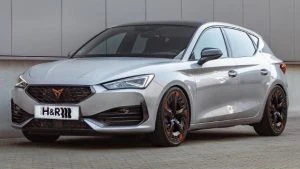
Cupra Leon
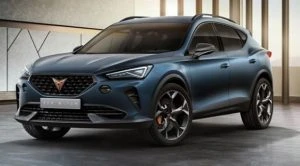
Cupra Formentor
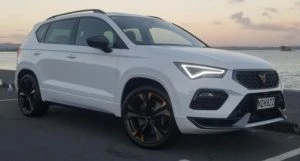
Cupra Ateca
Cupra is a Volkswagen-owned Spanish brand who have opened their doors to import their vehicles to Australia, offering us a 3-strong model range.
The exciting range of Cupra cars – Ateca (SUV), Leon (Hatchback), and Formentor (Crossover) – will spearhead the Australian line-up.
The Cupra Ateca SUV comes exclusively in the VZx form, so 221 kW of power and 400 Nm of torque is sent through the 4Drive AWD system to deliver 0-100 km/h in 4.9-seconds. I can see plenty of performance-SUV lovers who want to drive something as unique looking as the Cupra Ateca SUV wanting one!
The Cupra Leon Hatchback will be offered in VZ, VZe and VZx specification levels. So along with plenty of technology and differing variants, there will be a 2.0-litre turbo 140 kW/320 Nm, 180 kW/370 Nm, 180kW/400 Nm (Hybrid), and 221 kW/ 400Nm outputs respectively. So, there’s something for everyone here!
The Cupra Formentor is the Crossover Cupra and boasts the 4Drive AWD system on the V and VZx variants. Note the gorgeous crossover body styling that brings with it plenty of space, practicality and comfort.
All new Cupras sold in Australia will include a 5-year, unlimited kilometre warranty.
Volvo
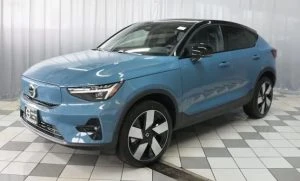
Volvo C40
Volvo has a new C40 coming! There are two versions offered that are based around one having a single electric motor and the other a dual electric motor layout. The Volvo C40 shares the electric powertrains with the XC40. Boot space is measured at 413 litres for both the single and dual motor versions.
Volvo’s the single motor C40 uses a 69 kWh battery pack and a single electric motor over the front axle. It produces 170 kW of power and 330 Nm of torque, combining nicely to provide drivers with a potential 0-100km/h dash being finished in 7.4 seconds. A full charge has a range of over 400 km.
Jump over to the Volvo C40 with its dual motor system, and you’ll find a larger 78 kWh battery pack. An electric motor for the front axle and an electric motor for the rear axle has this Volvo C40 equipped with AWD and capable of seeing off the 0-100km/h sprint in a claimed 4.7 seconds. That’s pretty swift! Again, a full charge should be able to take you over 400 km.
The single motor Volvo C40 kicks off at around $74,990, and the dual motor model around $82,490.
Audi
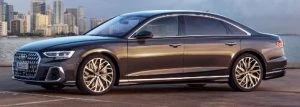
Audi A8
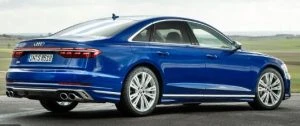
Audi S8
Audi’s A8 and S8 facelifts are coming. The A8 Sedan and Audi’s sportier S8 version have been a stunning proposition for some time, and they keep getting better. Quite an attractive large and luxurious sedan, the 2022 A8 delivers new levels of technology in the areas of comfort, entertainment, and safety.
The stunning A8 exterior remains similar to the outgoing model but you will find some nice subtle changes on the outside. 18–21-inch rims are available with six new designs to choose from. Audi’s ‘singleframe’ grille has been widened and pushed out at the bottom corners for a sportier, more athletic appearance.
The luxury sedan has grown a bit longer, making Audi’s flagship even more comfortable. It competes with the best big sedans from Mercedes Benz, BMW, and Lexus, so the relaxation seat package comes as no surprise, adding a back massage function, a foot warmer, an optional centre control console, and a fold-out table. 23 Bang and Olufsen speakers create an amazing audio sound.
Around the world, the new Audi A8 and A8 L versions will offer a wide selection of chiefly twin-turbo V6 engines that have 48-volt mild-hybrid assistance. All models will boast Quattro AWD and an 8-speed automatic. Audi S8 versions get the sweet-singing twin-turbo 4.0-litre V8 petrol ICE that can move this luxury–sports sedan from 0-100km/h in just 3.8 seconds. Boasting all-wheel steering, the S8 is a nimble thing of beauty.
Citroen
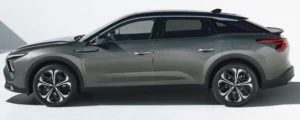
Citroen C5 X
Citroen calls the C5 X a “unique combination of the elegance of a sedan, the dynamism of a wagon and the elevated stance of an SUV”.
In my eyes, the new Citroen C5X looks both elegant and comfortable – just like a special Citroen should. The Citroen C5 X is a large 5-seater that measures 4805 mm in length. Luggage capacity is 485/1580 litres for the PHEV version and 545/1640 litres for the ICE car. Inside its cabin, you’ll find the C5 X is very comfortable, and the sensible interior layout is pleasant on the eye. A load of high-tech interior features include a digital driver’s display, a big 12.0-inch central touchscreen, Android Auto, Apple CarPlay, and a novel toggle gear shifter.
Adaptive dampers increase the Citroen C5 X’s ability out on the road, ensuring that those of us who love comfort can ride all day in a C5 X, all very comfortably indeed.
Equipped with the 165 kW/300 Nm 1.6-litre turbo-petrol four-cylinder ICE, the Australian version will have decent power (0-100 km/h in 8.8 seconds) while being hooked up to an 8-speed automatic transmission and FWD. A top speed of 232 km/h is doable. Citroen’s Australian importer is also considering launching the new Citroen C5 X with a PHEV powertrain. This system mates the 1.6-litre turbo ICE with an 81.2 kW electric motor and a 12.4 kWh lithium-ion battery for a total system output of 165 kW and a claimed electric range of 50 km (WLTP). The PHEV version is slightly quicker, boasting a 7.9 second time for the 0-100 km/h dash.
Peugeot
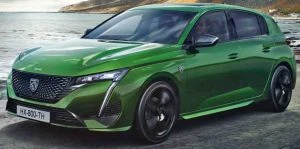
Peugeot 308
Peugeot is bringing us the next-generation 308 and the 3rd generation 308 is a classy looker from any angle you care to look at it from the curb side. Peugeot’s Australian line-up will consist of 4 variants: the 308 GT Hatch, 308 GT Premium Hatch and Wagon, and the Peugeot 308 GT Sport PHEV hatch – a plug-in hybrid (PHEV).
The PHEV versions of the 308 Hatch and Wagon will use larger batteries and more powerful motors than you’ll find in the smaller Peugeot e-208 supermini models. A Peugeot 308 GT Sport PHEV model sees a 132 kW 1.6-litre turbocharged 4-cylinder ICE unit paired to an 81 kW electric motor. The total output of the powertrain sends out a sprightly 165 kW of power and 360 Nm of torque to an AWD system for maximum traction and plenty of excitement.
New 308s with ICEs will be powered by a 1.2-litre turbocharged 3-cylinder petrol engine that produces 96 kW of power and 230 Nm of torque. This little engine is paired with an Aisin-sourced 8-speed automatic transmission that sends the power to the front wheels. Peugeot offers an e-308 in Europe, which is a pure electric variant.
Ford
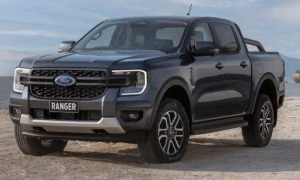
Ford Ranger Ute
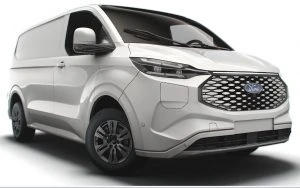
Ford E Transit
The new Ford Ranger Ute is packed with smart functionality and a cool ‘Tonka Toy’ appearance. Commands via voice, phone, or the central touchscreen has you controlling many of the infotainment features. Wireless phone charging, a smart climate control system, and a new digital cluster for the driver keeps the tough new Ford Ranger models at the head of the pack. Its chunkier styling with a wider stance, big towing capacity, and superior off-road ability are part of the new Ford Ranger experience.
Like the brand new Ford Everest SUV, the Ranger Ute houses the latest 3.0-litre turbo diesel V6 ICE, which is also offered alongside the existing 2.0-litre twin-turbo 4-cylinder diesel engine for 2022/23. The V6 boasts 184 kW of power at 3250 rpm and 600 Nm of torque from 1750-2250 rpm.
Ford’s latest E-Transit vans will be available with an all-electric powertrain for more efficient, zero-emissions driving.
Genesis
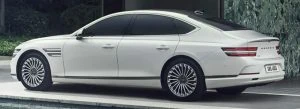
Genesis G80 Sedan
The charming Genesis G80 Sedan has gone pure EV and it is a stunner on the styling front. The car’s opulence and quiet ride will impress. An 87.2 kWh lithium-ion battery pack is housed under the floor, and a claimed Worldwide Harmonised Light Vehicle Test Procedure (WLTP) range of over 500 km is a decent amount of travel. The G80 EV Sedan has a pair of electric motors that work in unison to develop a maximum of 272 kW. This level of power combines with instantaneous torque of up to 700 Nm. These are powerful figures, allowing the luxurious Genesis Sedan to sprint from 0-100 km/h in less than 5 seconds.
Hyundai and Hydrogen
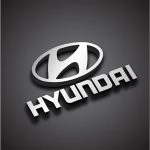
I’m showing my age a bit when I say that I can remember some of the earlier Hyundai cars – the Hyundai Pony and Hyundai Excel come to mind. Back in the 80s and early 90s, Hyundai cars were light, comfortable, and not really up to the same safety standards as the cars that were produced in other parts of the world. Nowadays, however, the story is completely different, and the South Korean automaker often tops crash safety tests with their vehicles, the vehicles are still comfortable, and the style and technology has won many awards. Hyundai has been always improving to the point where they are now a premium brand, very desirable, and leading the world on many fronts. Key new innovations from the Hyundai Motor Company (HMC) team are exciting and are part of Hyundai’s vision for building a cleaner, greener world that includes vehicles that no longer rely on fossil fuels.
Because of the past couple of years, where covid has taken the world’s centre stage, there has been a big shortage of semiconductors in the auto industry, to the point that some auto manufacturers have had to shut down. Semiconductors are used in the manufacture of electronic devices, including diodes, transistors, and integrated circuits. These devices have a wide application in anything electronic, including laptops, computers, appliances, and, of course, the modern automobile.
Like all vehicle manufacturers, HMC has been affected by the shortage and have had to temporarily suspend some of their factories. Despite the shortage, however, along with Toyota and Tesla, Hyundai is among a handful of automakers that actually increased their global sales despite the chip shortage.
However, Hyundai now plans to develop and build its own semiconductors so that they are not so reliant on chipmakers from other corners of the globe. Hyundai wants to make sure it has a steady supply of semiconductors for their projects on-and-into the future by making its own. It will be the parts and service arm for Hyundai, Kia and Genesis who would play a key role in the in-house development. Stockpiling the electronic chips would be important for Hyundai, so that when other global crisis occur, they will then be in a better position to weather the storm. Toyota and Tesla have already had stockpile contingency plans in place for some time, which has ensured that they fared well during covid.
Hyundai and Hydrogen
Hyundai are part of the Hydrogen Heavy Duty Vehicle Industry Group – comprised of hydrogen industry leaders Air Liquide, Hyundai, Nel Hydrogen, Nikola Corporation, Shell and Toyota. This Group has signed agreements with Tatsuno Corporation and Transfer Oil S.p.A. to industrialize globally-standard 70 MPa hydrogen heavy-duty vehicle high-flow (H70HF) fuelling hardware componentry. But, also, in Incheon, which is just west of Seoul, and in Ulsan, production plants will begin producing the hardware in the 2nd half of 2023 with an annual capacity of 100,000 hydrogen fuel cell systems.
South Korea’s influence on core Hydrogen components will see it as the world’s largest fuel cell production capacity, which will also help the HMC to diversify their business and tap into construction machinery and logistics equipment.
EVs might be the big talking point for some, but it is hydrogen that is the dark horse in the clean-green race. These two new fuel cell plants in Korea will accelerate the hydrogen economy and secure broader global market dominance. I reckon that Australia could be a hub for Hydrogen in the Pacific, don’t you think?
Hyundai’s wide-ranging hydrogen revolution accelerates with the showing of their 500 kW Vision FK sports car prototype and the e-Bogie autonomous commercial transport vehicles. HMG recently announced that it will launch next-generation hydrogen fuel-cell power units in 2023 that will double the power output, halve the cost, and reduce package size by 30%, when compared to current systems. Hyundai has a plan to offer “hydrogen for all” by 2040.
Hyundai’s Hydrogen Timeframe
In case you were not already aware, HMG is the parent of Hyundai, Kia and Genesis. By 2028, HMG says it will have applied fuel-cell systems to all of its heavy commercial vehicle models, including large trucks, significantly reducing transport-related CO2 emissions.
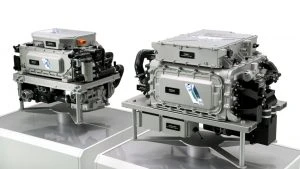
Hydrogen Fuel Cells
By 2030, Fuel-Cell Electric Vehicles (FCEV) will have achieved price parity with Battery Electric Vehicles (BEV), HMG says. And by 2040, HMG expects hydrogen to be available for everyone, for all vehicle types, and globally, triggering a lifestyle revolution.
Models for the Future
The Vision FK sports car is a 500 kW, hydrogen-powered high-performance prototype coupe that is capable of accelerating from 0-100 km/h in less than 4 seconds, while still offering a range of 600 km between top ups. The Vision FK’s fuel cell unit carries N Performance branding, suggesting that it would be a future Hyundai N model rather than a luxury-focused Genesis. HMG’s head of R&D, Albert Biermann, would not be drawn on when the Vision FK would go from prototype to production, but he did confirm that the next-generation Nexo fuel-cell SUV will launch “in the second half of 2023 followed by a Staria” The Staria is a people mover recently launched in Australia. “We are also working, of course, on fuel-cell cars for Kia and Genesis. That will take a little longer time. After 2025 you can expect further fuel cell applications.”
The e-Bogie commercial application is a fuel-cell-powered autonomous trailer that could revolutionise commercial transportation. Biermann also stated, “We are working full throttle on commercial [first] because that is the most effective way to avoid CO2. We are putting a lot of focus on fuel cells, not only for passenger cars but also for commercial vehicles.”
HMG’s Chairman, Euisun Chung, is even more emphatic about the significance of hydrogen fuel cell applications toward a sustainable future. “This may be the last train to a Hydrogen Society, and time is running out. Hydrogen is the most powerful and pragmatic solution to overcoming environmental challenges. Hydrogen mobility will accelerate human progress.”
He went on to say that Australia may have a role to play. “We know Australia is a country with vast and abundant renewable energy. We are exploring business opportunities in Australia with our partners. Our goal is to build a sustainable ecosystem for [a] global hydrogen society.”
He also said that, “We will not immediately phase out internal combustion engines (ICE) commercial vehicles, but we are not starting any new developments of ICE. No new models and no new platforms. Everything will go forward with BEVs and FCEVs.”
Interestingly, according to Hyundai’s head of fuel cell development, Mr Saehoon Kim, FCEV technology has one huge advantage over BEVs: “The main problem with [a] BEV is the scalability of batteries. For a small EV it’s okay, but for commercial large scale [operation] the question immediately is …. How are we going to stack all these batteries with the heavy weight, and who is going to be happy with the low range? So, in this case fuel cell fits perfectly.”
Hyundai’s heavy commercial fuel cell program is already well advanced. In mid-2020, 45 Hyundai Xcient fuel cell trucks began commercial operation in Switzerland. Biermann stated that the trucks covered 210,000 kilometres per month and have saved 130 tonnes of CO2 emissions every month in operation.
The key to Hyundai’s commercial strategy is its third-generation fuel-cell system, which is in the final stages of development. Hyundai expects to launch two units in 2023, one producing 100 kW for passenger vehicles and SUVs (including the next Nexo and Staria FCEVs), and a 200 kW unit for commercial applications. It has been said that by using two fuel-cell systems for trucks Hyundai can provide around 350 kW, which is equivalent to the power of current diesel engines used in trucking logistics.
This is all very exciting news and one that I have welcomed hearing. I’m a fan of the new hydrogen fuel-celled vehicle technology moving forward. This is Hyundai at its best, and we can only continue to watch this space.
Current Hyundai achievements:
The current ICE Hyundai i20 N has been crowned champion of Top Gear’s Speed Week. The 26 fastest cars in the world participated in Top Gear’s Speed Week 2021. It was the Hyundai· i20 N’s sharp handling and everyday usability that stood out to those in the Top Gear team.
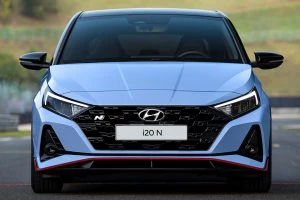
Hyundai i20N
Australian Car Sales Continue The Upwards Swing.
VFACTS and the FCAI have released the sales figures for March of 2021 and it’s good news. March 2021 saw 100,005 units moved, an increase of 18,315 over March of 2020. In a year to date sales sense it’s 263,648, up from 233,361 for the same time last year.
SUV sales were up 32 per cent and Light Commercial vehicles were up by 28 per cent. Eight of the top ten selling vehicles for the month were SUVs or Light Commercials, driven by increasing demand from the Private buyers.
Category wise, the passenger segment went down from 21,783 to 21,360. The SUV figures were 51,705 compared to 39,162 in March 2020. LCVs were 23,255, up from 18,165 in March 2020.
In the Passenger car segment Hybrids saw a slight increase, with 2,658, up from 2,441 in March 2020. Hybrid SUVs also saw an increase, with 2,190 in March 2020 up to 3,890 this year. PHEV SUVs doubled from 119 to 258.
For the Light Cars (under $25K), MG’s MG3 took the crown, with 1,238, an increase of over 30%. Third place was a real battle with Suzuki Swift (471), Kia Rio (452), and Suzuki Baleno (432) making a good sales fight, whilst in between was the Toyota Yaris on 636.
Small Cars (under $40K) and Toyota’s Corolla was under pressure from Hyundai’s i30. The Corolla moved 2,892 against 2,514. Third was tight with the Mazda3 just pipping the Kia Cerato, with 1,577 to 1,453. In the plus $40K range it was a battle between the German duo of BMW and Mercedes-Benz. The A-Class stole first on 358, just nudging the 1 Series on 340. The 2 Series Gran Coupe took third on 222.
For the Medium segment it was the Toyota Camry out in front in both the under and over $60K bracket. 852 units moved, ahead of the BMW 3 Series on 567, and the Mercedes-Benz C-Class on 364. Camry, though, was down substantially from 2020, with 1,332 last year.
Kia’s Stinger continued to win the Large Sedan, with 173, down by just two from last year. Porsche’s new Taycan, a fully Electric Vehicle, entered with 161, six ahead of the Mercedes-Benz E-Class.
Kia also outclassed the competition in the People Mover segment, with the Carnival reaching 616, up from 475 in March 2020. Honda’s Odyssey consolidates second with 162, up from 130.

Volkswagen snared third with its new Multivan for 121. In the over $60K segment it was Mercedes, Mercedes, and Toyota, with the V-Class (42), Valente (24) and Granvia (22), duking it out.
There’s been a change in the Sports car segment though. Ford’s Mustang still sold the most with 130 in the under $80K segment, however was outsold by the Mercedes-Benz in the over $80K by the C-Class Coupe and Convertible on 139. The 4 Series from BMW snared 110 for third in both segments.
Moving into the SUV segment and in the Light SUV category Mazda’s CX3 pummeled the opposition in the sub-$40K bracket with 1,744. Toyota’s Yaris Cross slid quickly into second on 846. For third it was another tight battle with Volkswagen’s T-Cross (655) edging out the Hyundai venue and Kia’s new Stonic on 636 and 624.
For the under $40K Small SUVs the Chinese made MG ZS stole the show on 1,510. Hyundai’s recently revamped Kona saw 1,462, just ahead of the Mazda CX-30 on 1,225. Nissan’s Qashqai was the only other entrant into the 1,000 club, squeaking in on 1,003.
Above $40K and Audi’s Q3 found 852 homes, ahead of the Volvo CX40 with 416. 279 and 249 went to Germany, with the X1 from BMW and GLA-Class from Mercedes. Mazda’s CX-5 gave the RAV4 a shake in the Medium sub-$60K, with Toyota selling 3,522 over the Mazda’s 3,022. Nissan’s X-Trail performed solidly for 1,932, just ahead of Subaru’s Forester with 1,439. Mitsubishi’s Outlander 1,085, just ahead of Honda’s CR-V on 972.
In the plus $60K bracket, only Mercedes cracked the 600 mark on 607 for the GLB. The GLC-Class wagon was a distant second with 374, with Audi Q5 on 336. The Lexus NX and BMW X5 went nose to nose on 295 and 291.

In the Large SUVs and under $70K it was Subaru’s outgoing and incoming Outback with 1,341, ahead of the 1,211 for Toyota’s Prado. 1,179 is the number for the Isuzu M-UX. Mitsubishi’s Pajero Sport sold 886, whilst their ancient Pajero, due to be cancelled at the end of the year, sold 292.
Over $70K and it was the X5 on 309. Behind it was some close infighting with the Lexus RX (185), Range Rover Sport (181), and GLE-Class wagon (176) providing stiff competition for each other. Above that it’s a two horse race in the Upper large under $100K, with the LandCruiser and Patrol on 2,244 and 305, selling nearly eight times as many than the full field in the over $100K bracket.
In the ute segment, the 4×4 pickup and cab-chassis bracket had HiLux on 4,068 ahead of Ford Ranger with 3,710, continuing the Japanese brand’s number one position. Mitsubishi’s 4×4 Triton moved 2,223 for third. Isuzu’s D-Max was fourth on 1,338, ahead of the Mazda BT-50 and sibling under the skin, on 1,177.
Notable in those figures is the rise of the sharply priced Chinese built MG range, and the continued growth of non-PHEV Hybrids. Overall for March 2021, Toyota sold 21,319, with Mazda on 10,785. They were the only two brands to see double-digits for the month. Hyundai continues to outpace its Korean sibling, with 6,852 over 5,802. Mitsubishi moved 6,430 whilst Nissan sold 4,559, under the 5,977 of Ford. MG? 3,303 and ahead of Honda.